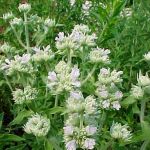| Common Name: |
Prairie Hyssop |
| Other Names: |
Virginia Mountain Mint, Wild Basil |
| Botanical Name: |
Pycnanthemum virginianum |
| Genus: |
Pycnanthemum |
| Family: |
Lamiaceae |
| Cultivation: |
Rich soil in sun or partial shade. |
| Propagation: |
By seed sown in spring or autumn; by division when dormant. |
| Harvest: |
Whole plants, leaves, and flowers are collected as flowering begins and used fresh for seasoning, or dried for use in infusions. |
| Native Location: |
N America (Quebec to North Dakota and southward) |
| Height: |
70-90cm (28-36in) |
| Width: |
20-60cm (8-24in) |
| Hardiness: |
Z5-10 |
| Parts Used: |
Whole plant, leaves, flowers, buds. |
| Properties: |
An aromatic, tonic, stimulant herb that increases perspiration, relaxes spasms, and improves digestion. |
| Medicinal Uses: |
Internally for indigestion, colic, chills, coughs, and fevers. |
| Culinary Uses: |
Leaves, flowering tops, and flower buds are used to flavor soups and savory dishes, and make an excellent mint-like tea. |
| Bibliography: |
Encyclopedia of Herbs by Deni Brown. Copyright © 1995, 2001 Dorling Kindersley Limited. pg 338
|

